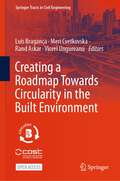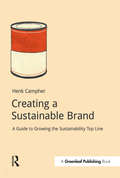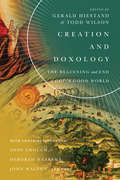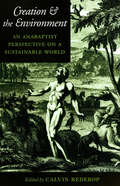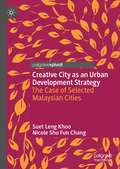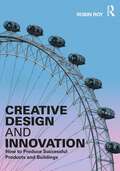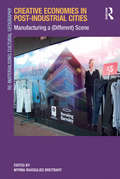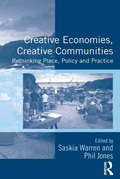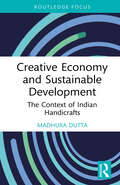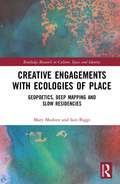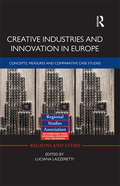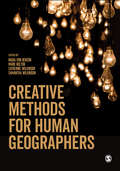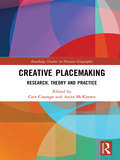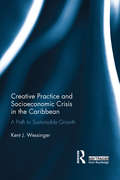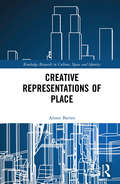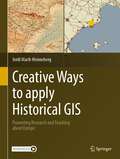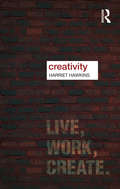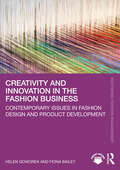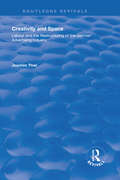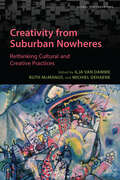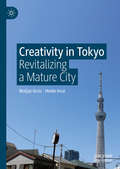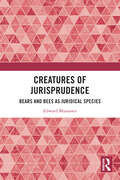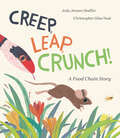- Table View
- List View
Creating a Roadmap Towards Circularity in the Built Environment (Springer Tracts in Civil Engineering)
by Viorel Ungureanu Luís Bragança Meri Cvetkovska Rand AskarThis open access book summarizes the research being pursued as part of the COST Action CA21103 titled "Implementation of Circular Economy in the Built Environment" (Circular B), which aims to define the methodology to develop a common circularity framework for inclusive application and assessment in new and existing buildings to support decision-making for all value chain stakeholders and appraise the implementation level of the European Circular Economy Action Plan (CEAP). The Action is increasingly gaining interest worldwide, bringing multidisciplinary young and experienced researchers together to share the latest studies and develop new knowledge. Consisting of 17 chapters corresponding to the conference themes, the book analyses and discusses topics such as Circular Economy (CE) best practices, design strategies for circular buildings, circular materials and products, adaptive reuse of existing buildings, recovery and reuse of salvaged materials and products, case studies of current applications and trends, barriers against CE implementation in buildings, efficient waste and circular resource management, circular lifecycle management and decision making, stakeholders relationships, CE supporting policies and barriers, circular business models, criteria, KPIs and assessment models for circular buildings, CE criteria in sustainability frameworks, digitalization and BIM for enhanced circularity of buildings and building materials, and standardization of CE definitions in buildings.
Creating a Sustainable Brand: A Guide to Growing the Sustainability Top Line (Doshorts Ser.)
by Henk CampherSustainable brands may have started as "doing less harm" and shaving costs off the bottom line. But brands today, supported by over a decade of phenomenal changes in sustainability, are looking for the holy grail of sustainable business – a fusion of products and branding that can actually drive sustainability and grow the business top line.Consumers have already joined the party. Just look at TOMS, Patagonia, Method, Seventh Generation, Dove and many more. What is missing isn’t the consumer but a better understanding of what fully-rounded consumers really want in their quest for a healthy, fulfilling life.This guide by sustainable brand expert Henk Campher is the model for creating a sustainable brand that people can trust, buy and above all, advocate for. Campher cuts through the myths and noise to offer an experienced expert's 101 for creating an irresistible brand, clearly setting out: what makes a product or service sustainable; the basic elements of sustainable branding strategy and a deep understanding of how consumers connect with a brand; an original model for assessing the sustainability of your brand, and; a host of examples of sustainable brands, drawing on the author's firsthand experience as part of the team at Edelman and Oxfam and founder of the Nelson Mandela initiated Proudly South African campaign.
Creation and Doxology: The Beginning and End of God's Good World (Center for Pastor Theologians Series)
by Todd Wilson Edited by Gerald HiestandThe doctrine of creation is crucial to the Christian faith, but it has often been maligned, misinterpreted, or ignored.
Creation and the Environment: An Anabaptist Perspective on a Sustainable World (Center Books in Anabaptist Studies)
by Calvin RedekopRecent years have seen a shift in the belief that a religious world-view, specifically a Christian one, precludes a commitment to environmentalism. Whether as "stewards of God's creation" or champions of "environmental justice," church members have increasingly found that a strong pro-ecology stand on environmental issues is an integral component of their faith. But not all Christian denominations are latecomers to the issue of environmentalism. In Creation and the EnvironmentCalvin W. Redekop and his co-authors explain the unique environmental position of the Anabaptists, in particular the Mennonites.After a brief survey of the major forces contributing to the word's present ecological crisis, Creation and the Environment explores the uniquely Anabaptist view of our relationship to what they see as the created order. In rural Amish and Mennonite communities, they explain, the environment—especially the "land"—is considered part of the Kingdom God plans to establish on earth. In this view, the creation is part of the divine order, with the redemption of humankind inextricably linked to the redemption and restoration of the material world. The well-being a purpose of creation and human history are thus seen as completely interdependent.Contributors: Donovan Ackley III, Claremont Graduate School • Kenton Brubaker, Eastern Mennonite University • Thomas Finger, Claremont Graduate School • Karen Klassen Harder, Bethel College, Kansas • James Harder, Bethel College, Kansas • Lawrence Hart, Cheyenne Cultural Center, Clinton, Oklahoma • Theodore Hiebert, McCormick Theological Seminary • Karl Keener, Pennsylvania State University • Walter Klaassen, Conrad Grebel College • David Kline, Holmes County, Ohio • Calvin W. Redekop, Conrad Grebel College • Mel Schmidt • Dorothy Jean Weaver, Eastern Mennonite University • Michael Yoder, Northwestern College, Iowa.
Creative City as an Urban Development Strategy: The Case of Selected Malaysian Cities
by Suet Leng Khoo Nicole Shu ChangThis book is a pioneering work to position the creative city concept within Malaysian urban development discourse. The chapters are written and systematically sequenced to be all-encompassing and comprehensible to audiences both from the academic and non-academic realms. The nascency of creative city development in Malaysia has motivated the timely exploration of the viability of this strategy for selected Malaysian cities (i.e. Kuala Lumpur, George Town, Ipoh, Johor Bahru). The book also discusses the global discourse on creative city and its critiques. This is followed by an overview of Malaysia’s macrolevel socio-economic and political structures as well as national policies to frame the Malaysian creative city narrative. The case study chapters are novel, as each Malaysian city unravels its unique experiences and dissects the way the city responds to the creative city agenda amidst local nuances and idiosyncrasies.
Creative Design and Innovation: How to Produce Successful Products and Buildings
by Robin RoyUsing many real-world examples and cases, this book identifies key factors and processes that have contributed to the creation of successful new products, buildings, and innovations, or resulted in some failures. Such factors include the creativity of individuals and groups, their sources of inspiration, the processes of creative design and innovation, and the characteristics of the products, buildings, and innovations themselves. Much has been written about creativity and innovation, but what helps to foster creativity, enable creative ideas to be translated into practical designs, and ensure those new products or buildings succeed as innovations on the market or in use? This book discusses these elements through the author’s origination and analysis of examples and case studies ranging from the revolutionary innovation of the smartphone, through radical innovations in domestic appliances and sustainable housing, to creative designs of contemporary jewellery. The broad range of examples and cases include product and fashion design, filmmaking and fine art, as well as industrial design, engineering, and architecture, offering lessons for creatives, designers, and innovators from many subject backgrounds. Analysis of the different factors, successes, and failures are presented in text boxes throughout the book to allow readers to easily understand the key lessons from each example or case, with numerous colour visuals, diagrams, and charts for illustration. This book is a must-read for a broad audience interested in creativity, design, and innovation, including practitioners in design, engineering, architecture, and product management, and students and instructors of those subjects.
Creative Economies in Post-Industrial Cities: Manufacturing a (Different) Scene (Re-materialising Cultural Geography Ser.)
by Myrna Margulies BreitbartThere has been much written on the new creative economy, but most work focuses on the so-called 'creative class,' with lifestyle preferences that favor trendy new restaurants, mountain biking, and late night clubbing. This 'creative class,' flagship cultural destinations, and other forms of commodity-driven cultural production, now occupy a relatively uncritical place in the revitalization schemes of most cities up and down the urban hierarchy. In contrast, this book focuses on small- to medium-size post-industrial cities in the US, Canada, and Europe that are trying to redress the effects of deindustrialization and economic decline through cultural economic regeneration. It examines how culture-infused economic opportunities are being incorporated into planning in distinct ways, largely under the radar, in many working class communities and considers to what extent places rooted in an industrial past are able to envisage a different economic future for themselves. It questions whether these visions replicate strategies employed in larger cities or put forth plans that better suit the unique histories and challenges of places that remain outside the global limelight. Exploring the intersection between a cultural and sustainable economy raises issues that are central to how urban regeneration is approached and neighborhood needs and assets are understood. Case studies in this book examine spaces and planning processes that hold the possibility of addressing inequality by forging new economic and social relationships and by embarking on more inclusive and collaborative experiments in culture-based economic development. These examples often focus on building upon the assets of existing residents and broadly define creativity and talent. They also acknowledge both the economic and non-monetary value of cultural practices. This book maintains a critical edge, incorporating left critiques of mainstream creative economy theories and practices into empirical case studies that depart from standard cultural economy discourse. Structural barriers and unequal distributions of power make the search for viable urban development alternatives especially difficult for smaller post-industrial cities and risk derailing even creative grassroots initiatives. While acknowledging these obstacles, this book moves beyond critique and focuses on how the growing economy surrounding culture, the arts, and ecological design can be harnessed and transformed to best benefit such cities and improve the quality of life for its residents.
Creative Economies, Creative Communities: Rethinking Place, Policy and Practice
by Phil Jones Saskia WarrenInvestigating how people and places are connected into the creative economy, this volume takes a holistic view of the intersections between community, policy and practice and how they are co-constituted. The role of the creative economy and broader cultural policy within community development is problematised and, in a significant addition to work in this area, the concept of ’place’ forms a key cross cutting theme. It brings together case studies from the European Union across urban, rural and coastal areas, along with examples from the developing world, to explore tensions in universal and regionally-specific issues. Empirically-based and theoretically-informed, this collection is of particular interest to academics, postgraduates, policy makers and practitioners within geography, urban and regional studies, cultural policy and the cultural/creative industries.
Creative Economy and Sustainable Development: The Context of Indian Handicrafts (Routledge Focus on the Global Creative Economy)
by Madhura DuttaThe creative economy is one of the world’s most dynamic sectors. Drawing upon the author’s work on empowerment and sustainability, this book focuses on India's indigenous, rural, traditional handicraft-based creative and cultural industries (CCIs) and the role they can play in the country’s creative economy. The book combines a comprehensive assessment of the region's deeply rooted cultural and creative resources with practical cases of self-sufficient creative skills and knowledge-based entrepreneurship across the Indian handicrafts sector. The author illuminates how sustainability, resilience, and collective well-being, along with unique regional characteristics, are converging towards generating an independent creative and cultural economy that does not depend on global brands and businesses alone. The disconnect between associated policies, practice, and academic work is addressed by contextualizing the case studies in terms of modern economic theory and practice, relevant administrative policies of South Asia, and recognition of the role of culture in achieving the sustainable development goals. This concise yet comprehensive book provides an insightful and holistic understanding of India’s handicrafts economy which will be valuable reading for researchers and reflective practitioners.
Creative Engagements with Ecologies of Place: Geopoetics, Deep Mapping and Slow Residencies (Routledge Research in Culture, Space and Identity)
by Mary Modeen Iain BiggsThis book explores an exciting range of creative engagements with ecologies of place, using geopoetics, deep mapping and slow residency to propose broadly based collaborations in a form of ‘disciplinary agnosticism’. Providing a radical alternative to current notions of interdisciplinarity, this book demonstrates the breadth of new creative approaches and attitudes that now challenge assumptions of the solitary genius and a culture of ‘possessive individualism’. Drawing upon a multiplicity of perspectives, the book builds on a variety of differing creative approaches, contrasting ways in which both visual art and the concept of the artist are shifting through engagement with ecologies of place. Through examples of specific established practices in the UK, Australia and the USA, and other emergent practices from across the world, it provides the reader with a rich illustration of the ways in which ensemble creative undertakings are reactivating art’s relationship with place and transforming the role of the artist. This book will be of interest to artists, art educators, environmental activists, cultural geographers, place-based philosophers and postgraduate students and to all those concerned with the revival of place through creative work in the twenty-first century.
Creative Industries and Innovation in Europe: Concepts, Measures and Comparative Case Studies (Regions and Cities #57)
by Ron Martin Luciana Lazzeretti Maryann Feldman Gillian Bristow Gernot GrabherIn recent years, the study of creativity has shifted from analysis of culture as an end in itself to one of economic enhancement, and its capability to generate wealth and promote economic development. Increasingly, European cities and regions are using the arts to fuel wellbeing and reinvigorate economies after the comparative demise of more traditional industry and manufacturing. A growing literature is starting to highlight the innovation capacity of cultural and creative industries (CCIs) as they intersect the innovation processes of other manufacturing and services sectors with an innovative and creative output. Culture and creativity may be a strategic weapon to exit the present crisis and redefine an economic model of sustainable development. This book brings together a set of multidisciplinary contributions to investigate the kaleidoscope of European creativity, focussing on CCIs and the innovations connected with them. The two main questions that this volume aims to address are: How can we identify, map and define CCIs in Europe? And how do they contribute to innovation and sustainable growth? The volume is split into two parts. The first part deals with the definition, measurement and mapping of the geography of European CCIs according to a local economic approach, focussing on Italy, Spain, the UK, Austria, Denmark and France. This section surveys the different industrial typologies and spatial patterns, which underline a significant dissimilarity between the North and the South of Europe, mainly due to the difference between heritage-driven and technology-driven countries. The section concludes with a case study on a Japanese creative city. The second part collects some interesting cases of innovation generated in creative spaces such as cities of art or creative clusters and networks. This entails the study of innovations among creative and non-creative sectors (e.g. laser technologies in conservation of works of art and design networks in Italy) and across European and non-European countries (e.g. Spaghetti Western movies in the US or visual artists in New Zealand). Finally, an innovation capacity of culture that can regenerate mature sectors (e.g. the French food supply chain and Swiss watch Valley) or combine the creative and green economics paradigms (e.g. the green creative cities in North Europe) is analyzed. This book will appeal to academics, scholars and practitioners of urban and regional studies, cultural and creative economics and managerial and organization studies.
Creative Margins
by Alison L. BainSuburbs can be incubators of creativity: innovative and complex, but all too often underappreciated. In Creative Margins, Alison L. Bain documents the unique role of Canadian artists and cultural workers in suburban place-formation and dismantles mischaracterizations of suburbs as cultural wastelands.Creative Margins interweaves stories of the challenges and opportunities presented by the creation of culture in suburbs, focusing on Etobicoke and Mississauga outside Toronto, and Surrey and North Vancouver outside Vancouver. The book investigates whether the creative process unfolds differently for suburban and urban cultural workers, as well as how this process is affected by the presence or absence of cultural infrastructure and planning initiatives.Bain shows how suburban culture can enhance a city-region's vitality and sustainability. This book firmly debunks the myth of culture as a solely urban phenomenon and demonstrates the social and economic merits of investing in suburban art and culture.
Creative Methods for Human Geographers
by Nadia Von Benzon Catherine Wilkinson Mark Holton Samantha WilkinsonIntroducing a broad range of innovative and creative qualitative methods, this accessible book shows you how to use them in research project while providing straightforward advice on how to approach every step of the process, from planning and organisation to writing up and disseminating research. It offers: Demonstration of creative methods using both primary or secondary data. Practical guidance on overcoming common hurdles, such as getting ethical clearance and conducting a risk assessment. Encouragement to reflect critically on the processes involved in research. The authors provide a complete toolkit for conducting research in geography, while ensuring the most cutting-edge methods are unintimidating to the reader.
Creative Methods for Human Geographers
by Nadia Von Benzon Catherine Wilkinson Mark Holton Samantha WilkinsonIntroducing a broad range of innovative and creative qualitative methods, this accessible book shows you how to use them in research project while providing straightforward advice on how to approach every step of the process, from planning and organisation to writing up and disseminating research. It offers: Demonstration of creative methods using both primary or secondary data. Practical guidance on overcoming common hurdles, such as getting ethical clearance and conducting a risk assessment. Encouragement to reflect critically on the processes involved in research. The authors provide a complete toolkit for conducting research in geography, while ensuring the most cutting-edge methods are unintimidating to the reader.
Creative Placemaking: Research, Theory and Practice (Routledge Studies in Human Geography)
by Cara Courage Anita McKeownThis book makes a significant contribution to the history of placemaking, presenting grassroots to top-down practices and socially engaged, situated artistic practices and artsled spatial inquiry that go beyond instrumentalising the arts for development. The book brings together a range of scholars to critique and deconstruct the notion of creative placemaking, presenting diverse case studies from researcher, practitioner, funder and policymaker perspectives from across the globe. It opens with the creators of the 2010 White Paper that named and defined creative placemaking, Ann Markusen and Anne Gadwa Nicodemus, who offer a cortically reflexive narrative on the founding of the sector and its development. This book looks at vernacular creativity in place, a topic continued through the book with its focus on the practitioner and community-placed projects. It closes with a consideration of aesthetics, metrics and, from the editors, a consideration of the next ten years for the sector. If creative placemaking is to contribute to places-in-the-making and encourage citizenled agency, new conceptual frameworks and practical methodologies are required. This book joins theorists and practitioners in dialogue, advocating for transdisciplinary, resilient processes.
Creative Practice and Socioeconomic Crisis in the Caribbean: A path to sustainable growth
by Kent J. WessingerAlthough the world is saturated with extraordinary methods, innovation, and technology, the Caribbean seems to have been left behind in the sustainable growth of global development. While the majority of the world defines the Caribbean as "paradise," the reality of life for Afro-Caribbean culture is defined by an unrelenting hardship. This book comprehensively analyzes this phenomenon from a unique and intimate perspective in order to offer a viable pathway to sustainable growth. By examining the historic progression of the Caribbean region and the African culture within, the author explores the relationship between creative practice and socioeconomic crisis and questions whether limited access to environments that facilitate original and conceptual ideas correlates with socioeconomic crisis. The outcomes and methods of analysis developed in this book are a useful tool for other cultures or organizations seeking to diffuse socioeconomic crisis and implement a pathway of sustainable growth. This innovative book will be of great interest to students and scholars of cultural and sustainability studies, Caribbean and African Studies, as well as Development and Sustainable Development
Creative Representations of Place (Routledge Research in Culture, Space and Identity)
by Alison BarnesCultural geography and the social sciences have seen a rise in the use of creative methods with which to understand and represent everyday life and place. Conversely, many artists are producing work that centres on ideas of place and space and utilising empirical research methods that have a resonance with geographers. This book contributes to the body of literature emerging from such creative approaches to place. Drawing together theory and practice from cultural geography, anthropology and graphic design, this book proposes an interdisciplinary geo/graphic process for interrogating and re/presenting everyday life and place. A diverse set of research projects highlights participatory and autoethnographic approaches to the research. The sites of the projects are varied, encompassing the commercial space of grocery shops, cafés and restaurants, the private, domestic space of the home, and a Scottish World Heritage site. The theoretical context of each project highlights the transferability of the geo/graphic process, with place being variously framed within discussions of food, multi-culturalism and belonging; home, collecting and meaningful possessions; and, materiality, memory and affect. Themes in the book will appeal to researchers working in the creative methods field. This book will also be essential supplementary reading for postgraduate students studying Cultural Geography, Experimental Geographies, Visual Anthropology, Art and Design.
Creative Ways to apply Historical GIS: Promoting Research and Teaching about Europe
by Jordi Martí-HennebergThis volume promotes the use of Historical GIS (H-GIS) for both education and research. It consists of a coherent set of chapters that allow readers to study the spatial histories of cities, infrastructure, landscapes, and more across Europe. Each chapter is accompanied by Electronic Supplementary Material (ESM) including GIS data, guides and complementary material in .pdf format, and more. To date, there are no similar materials available in this field compiled in a single book. Interdisciplinarity in spatial research is a main theme of this volume, and the text and tools provided here allow readers to combine inputs relating to the study of earth sciences, population, urban growth and transportation, focusing on changes over both space and time. Each chapter provides data in GIS format and also a user's guide to enable readers to deeply engage with the contents themselves. Guidelines are provided to help locate new data about other areas of the world, which users will be able to develop independently. The book is divided into three parts, each presenting different scales of study and analysis at the local, regional and national levels. Part One deals with general subjects analyzed across large areas, mainly within Europe. Part Two provides more specific subjects and data. Part Three covers sources and teaching with H-GIS. The book will be of interest to researchers, academics, teachers and students from secondary schools up to university level. Each subject and tutorial is aimed at a multi-level audience.
Creativity (Key Ideas in Geography)
by Harriet HawkinsCreativity, whether lauded as the oil of the 21st century, touted as a driver of international policy, or mobilised by activities, has been very much part of the zeitgeist of the last few decades. Offering the first accessible, but conceptually sophisticated account of the critical geographies of creativity, this title provides an entry point to the diverse ways in which creativity is conceptualized as a practice, promise, force, concept and rhetoric. It proffers these critical geographies as the means to engage with the relations and tensions between a range of forms of arts and cultural production, the cultural economy and vernacular, mundane and everyday creative practices. Exploring a series of sites, Creativity examines theoretical and conceptual questions around the social, economic, cultural, political and pedagogic imperatives of the geographies of creativity, using these geographies as a lens to cohere broader interdisciplinary debates. Central concepts, cutting-edge research and methodological debates are made accessible with the use of inset boxes that present key ideas, case studies and research. The text draws together interdisciplinary perspectives on creativity, enabling scholars and students within and without Geography to understand and engage with the critical geographies of creativity, their breadth and potential. The volume will prove essential reading for undergraduate and post-graduate students of creativity, cultural geography, the creative economy, cultural industries and heritage.
Creativity and Innovation in the Fashion Business: Contemporary Issues in Fashion Design and Product Development (Mastering Fashion Management)
by Helen Goworek Fiona BaileyCreativity and Innovation in the Fashion Business explores the ways in which creativity and innovation play a central role across the fashion industry, paying particular attention to design and technical perspectives. This topic is examined through careful theoretical analysis, incorporating the perspectives of multiple contributors who together possess a wealth of combined experience in creative and technical roles in the fashion business.Broad in scope, this textbook first provides a wide overview of creativity and innovative developments across the industry, before considering technical and digital innovation in production and product development, as well as trend forecasting. The final part of the book then consists of an exploration of sustainable innovation in design for fashion brands and retailers. Each chapter includes aims and summaries to structure learning and highlight key points, academic insights from thought leaders and interviews from industry and academia.A vital introductory textbook, Creativity and Innovation in the Fashion Industry is well-suited to undergraduate and postgraduate modules across subjects such as Fashion Business, Fashion Design and Manufacturing, Product Development, Innovation Management, and Buying and Merchandising. Online resources include PowerPoint slides and a test bank.
Creativity and Space: Labour and the Restructuring of the German Advertising Industry (Routledge Revivals)
by Joachim ThielOriginally published in 2005. By examining the changing patterns of the German advertising industry from a spatial-economic perspective, focusing on the rise of Hamburg as the country's new creative capital, this book discusses the shifting relations between economic organization, social relations and spatial structures in the post-industrial economy. It argues that it is the professional labour market which drives the organization and the spatial structure of knowledge-intensive activities. It does not, however, only imply the increasing importance of labour as a factor of production, but also suggests an increasing uncertainty linked to the nature of knowledge - labour. Illustrated by in-depth empirical material, the book brings together debates on reflexive modernization and individualization with those on embeddedness and on the role of business services in regional development. It concludes that it is the labour market of professionals which provides a regional and social anchoring of economic activities, while at the same time pointing out the increasing importance of metropolitan regions.
Creativity from Suburban Nowheres: Rethinking Cultural and Creative Practices (Global Suburbanisms)
by Ilja Van Damme Michiel Dehaene Ruth McManusLooking at suburbs as places of creativity gives rise to novel and thought-provoking narratives that typically run counter to the idea that suburbs are sites of "ordinary," "mundane," and "everyday" practices. Far from being geographies of "nowhere" – dull, materialistic, and monotone – suburbs are unpacked as being heterogeneous and historically layered places of living, work, and creation. Situating creativity in place and time, Creativity from Suburban Nowheres displaces mainstream understandings of creativity and widespread stereotypes commonly associated with the suburbs. Contributors explore the particular forms of creativity that suburbs elicit both in the process of their making, materialization, and community construction, and in the myriad ways in which suburbs are inhabited and experienced. They highlight accounts of suburbs as places that give people the space and latitude to shape individual and collective identities through creative practices at odds with mainstream culture, and often remote from the classic agglomeration "assets" associated with inner cities. Anchored in historical and geographical research, this volume highlights how and in what forms creativity should be understood in the suburbs, why and when creativity can be found, and how the notion of suburban creativity overthrows ingrained and dominant normative viewpoints. Rather than seeing creativity arise despite its suburban location, Creativity from Suburban Nowheres illuminates the emancipatory potential of suburbs for creativity.
Creativity in Tokyo: Revitalizing a Mature City
by Heide Imai Matjaz UrsicThis book focuses on overlooked contextual factors that constitute the urban creative climate or innovative urban milieu in contemporary cities. Filled with reflections based on interviews with a diverse range of creative actors in various local neighborhoods in Tokyo, it offers a rare glimpse into the complex set of elements that provide long-term, physical, and sociocultural support to urban creativity. Ursic and Imai highlight the interplay between physical and soft (social) factors in the process of place-making and explore how a city’s creativity is influenced by financial support and accessible infrastructure, as well as the sets of informal networks, services, and tacit, locally embedded knowledge that provide the basic layers of stimuli needed for creativity to fully develop. The authors show how the future development of creativity and the overall development of a city depend not only on the (top-down) planning strategies of formal authorities, but also on the appropriate (bottom-up) inclusion of heterogeneous elements that are provided and embedded within the small, hidden context of city spaces.
Creatures of Jurisprudence: Bears and Bees as Juridical Species
by Edward MussawirTo what extent can an animal constitute a ‘juridical species’? This highly original book considers how animals have been integral to law and to legal thinking.Going beyond the traditional approaches to animal rights and the question of whether non-human animals may be considered legal ‘subjects,’ this book follows two types of animal – bears and bees – and asks what existence these species have maintained in juridical thought. Uncovering surprising roles that the animals play in the imagination of and solution to jurisprudential problems, the book offers a counter-argument to the view that juridical thought reduces one’s appreciation for the singularity and independence of their lives. It shows, rather, that the animals exert a remarkable influence on the creative dimensions of law, offering a liveliness to it that is worthy of close attention.Contributing to new directions at the intersection of jurisprudence and human–animal studies, this book will appeal to those with interests in either of these areas.
Creep, Leap, Crunch! A Food Chain Story
by Jody Jensen ShafferIn this nonfiction picture book, discover how the animal kindgdom's food chain takes shape, from the lowly worm to the mighty king of the jungle.There was a blue sky with a bright shining sun,A dazzling, life-giving, fiery sun.The day had begun. Follow along as a day in the life of the food chain begins. From the sun that shines upon the grass and trees to the animals that feed each other, each element in nature has its place. But what happens when the food escapes? This cumulative story will delight, with a surprise ending that all science lovers will enjoy.
